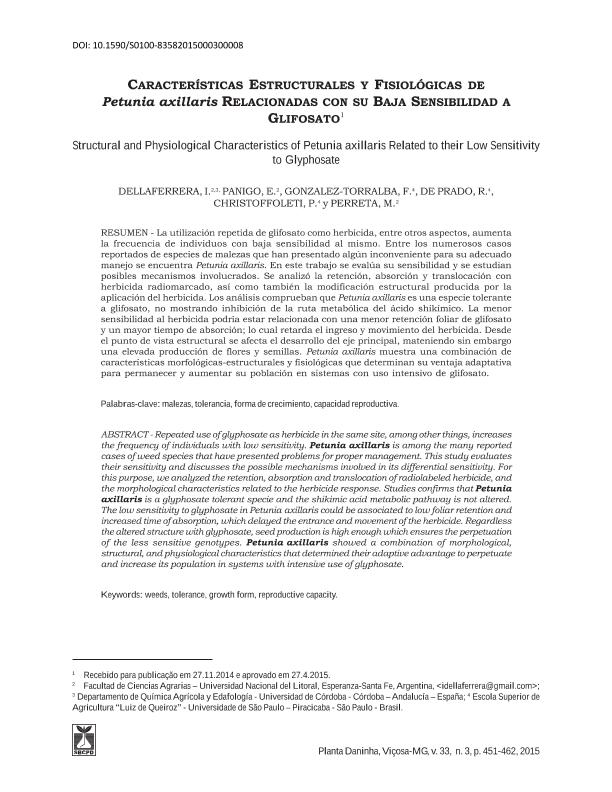Artículo
La utilización repetida de glifosato como herbicida, entre otros aspectos, aumenta la frecuencia de individuos con baja sensibilidad al mismo. Entre los numerosos casos reportados de especies de malezas que han presentado algún inconveniente para su adecuado manejo se encuentra Petunia axillaris. En este trabajo se evalúa su sensibilidad y se estudian posibles mecanismos involucrados. Se analizó la retención, absorción y translocación con herbicida radiomarcado, así como también la modificación estructural producida por la aplicación del herbicida. Los análisis comprueban que Petunia axillaris es una especie tolerante a glifosato, no mostrando inhibición de la ruta metabólica del ácido shikímico. La menor sensibilidad al herbicida podría estar relacionada con una menor retención foliar de glifosato y un mayor tiempo de absorción; lo cual retarda el ingreso y movimiento del herbicida. Desde el punto de vista estructural se afecta el desarrollo del eje principal, mateniendo sin embargo una elevada producción de flores y semillas. Petunia axillaris muestra una combinación de características morfológicas-estructurales y fisiológicas que determinan su ventaja adaptativa para permanecer y aumentar su población en sistemas con uso intensivo de glifosato. Repeated use of glyphosate as herbicide in the same site, among other things, increases the frequency of individuals with low sensitivity. Petunia axillaris is among the many reported cases of weed species that have presented problems for proper management. This study evaluates their sensitivity and discusses the possible mechanisms involved in its differential sensitivity. For this purpose, we analyzed the retention, absorption and translocation of radiolabeled herbicide, and the morphological characteristics related to the herbicide response. Studies confirms that Petunia axillaris is a glyphosate tolerant specie and the shikimic acid metabolic pathway is not altered. The low sensitivity to glyphosate in Petunia axillaris could be associated to low foliar retention and increased time of absorption, which delayed the entrance and movement of the herbicide. Regardless the altered structure with glyphosate, seed production is high enough which ensures the perpetuation of the less sensitive genotypes. Petunia axillaris showed a combination of morphological, structural, and physiological characteristics that determined their adaptive advantage to perpetuate and increase its population in systems with intensive use of glyphosate.
Características estructurales y fisiológicas de petunia axillaris relacionadas con su baja sensibilidad a glifosato
Título:
Structural and physiological characteristics of petunia axillaris related to their low sensitivity to glyphosate
Dellaferrera, Ignacio Miguel ; Panigo, Elisa
; Panigo, Elisa ; Gonzalez Torralba, F.; Prados, Romina del Valle
; Gonzalez Torralba, F.; Prados, Romina del Valle ; Christoffoleti, Pedro Jacob; Perreta, Mariel Gladis
; Christoffoleti, Pedro Jacob; Perreta, Mariel Gladis
 ; Panigo, Elisa
; Panigo, Elisa ; Gonzalez Torralba, F.; Prados, Romina del Valle
; Gonzalez Torralba, F.; Prados, Romina del Valle ; Christoffoleti, Pedro Jacob; Perreta, Mariel Gladis
; Christoffoleti, Pedro Jacob; Perreta, Mariel Gladis
Fecha de publicación:
07/2015
Editorial:
Universidade Federal Vicosa. Sociedade de Investigacoes Florestais
Revista:
Planta Daninha
ISSN:
0100-8358
e-ISSN:
1806-9681
Idioma:
Español
Tipo de recurso:
Artículo publicado
Clasificación temática:
Resumen
Palabras clave:
GROWTH FORM
,
REPRODUCTIVE CAPACITY
,
TOLERANCE
,
WEEDS
Archivos asociados
Licencia
Identificadores
Colecciones
Articulos(CCT - SANTA FE)
Articulos de CTRO.CIENTIFICO TECNOL.CONICET - SANTA FE
Articulos de CTRO.CIENTIFICO TECNOL.CONICET - SANTA FE
Citación
Dellaferrera, Ignacio Miguel; Panigo, Elisa; Gonzalez Torralba, F.; Prados, Romina del Valle; Christoffoleti, Pedro Jacob; et al.; Características estructurales y fisiológicas de petunia axillaris relacionadas con su baja sensibilidad a glifosato; Universidade Federal Vicosa. Sociedade de Investigacoes Florestais; Planta Daninha; 33; 3; 7-2015; 451-462
Compartir
Altmétricas



